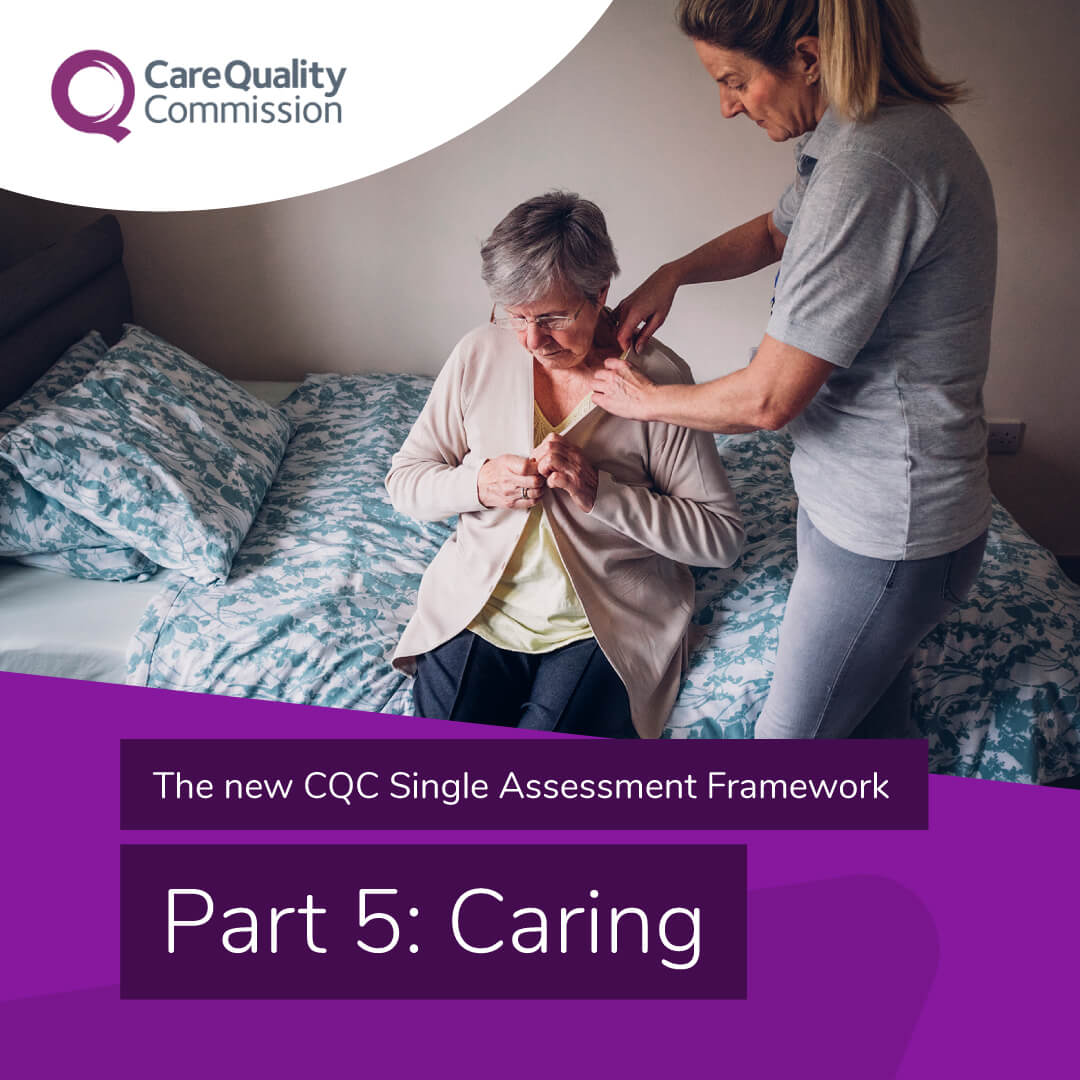This article on one aspect of the Single Assessment Framework is part of a wider series. The links are below:
- The new CQC Single Assessment Framework. What we know so far.
- Care Quality Commission and moving forward with the Single Assessment Framework
- Single Assessment Framework – Are you transition ready?
- Single Assessment Framework – What does SAFE look like?
- Single Assessment Framework – What does EFFECTIVE look like?
- Single Assessment Framework – What does RESPONSIVE look like?
- Launch of the CQC new provider portal
What does a CARING service look like?
An embedded culture of Caring across services is rarely in question. However, services should regularly monitor and analyse the experience of a range of stakeholders. This will show how well the key questions are being met. You might say ‘of course our services is Caring’ but how do you actually measure it?
Whole communities are accessing services in various capacities and roles. People may be receiving health care either independently or with the support of an advocate, others will be working within service delivery which will for some, involve signposting and referring people to other services. Therefore, looking at the complete circle of care, which is unique to each person is fundamental in answering the key question of Caring.
Whatever viewpoint people are coming from, they expect services to have a culture of compassion, kindness and empathy and one where equity, dignity and respect, is a focus. People want to experience integration of care which is seamless and one which strives for positive outcomes for people using services.
Staff and leaders should expect to work within environments that are Caring where support is readily available. In roles that can be isolating and emotionally challenging, staff wellbeing should be a focus. For providers of home care it is crucial to show how lone workers are supported and kept safe in their roles and how they are integrated as part of a wider team.
CQC guidance is clear on the key question of Caring, the quality statements and related regulations. The quality statements which relate to the key question of Caring are as follows:
- Kindness, compassion and dignity
- Treating people as individuals
- Independence, choice and control
- Responding to people’s immediate needs
- Workforce wellbeing and enablement
Practical tips for evidence collection
A good starting point is to think about the aspects of the unique circle of care that encompass individual service users. Think about how people are cared for and treated as individuals. How their choices and preferences are met and their independence achieved. Are they supported to be in control of their lives? Next, look with a wider view. How Caring is the service in addressing immediate and changing needs, concerns, complaints and incidents? How does the service actively respond to areas of improvement in the area of the key question of Caring.
CareLineLive users will find that there are numerous ways that the features can provide evidence of a Caring service. There are ample opportunities to showcase person-centered care planning and risk management. The review feature allows users to schedule bespoke review and quality management timelines. The detailed person-centred care tasks are created on the management portal and are accessed by individual carers through the carer app.
Let’s look at what evidence can be provided when addressing the key question and quality statements of Caring.
Note: There is will be a crossover of evidence types for the quality statements, below are some suggestions for the key question of Caring.
Kindness, compassion and dignity
We always treat people with kindness, empathy and compassion and we respect their privacy and dignity. We treat colleagues from other organisations with kindness and respect.
Evidence suggestions:
- Person-centred care planning, reviews, risk assessments and risk management, which is compassionate and kind and clearly evidences how respect, dignity and privacy are a key part of every service user’s experience. This can be reflected in collaborative working and service delivery.
- Detailed ‘About Me’ assessment showing, in detail, what is important to individual service users. Evidence of how this information is shared with relevant stakeholders.
- Person-centred tasks which show attention to detail
- Feedback from service users, staff and stakeholders that evidences how the service treats people with kindness, compassion and dignity. This can include how highlighted areas from feedback are used to improve the service.
Treating people as individuals
We treat people as individuals and make sure their care, support and treatment meets their needs and preferences. We take account of their strengths, abilities, aspirations, culture and unique backgrounds and protected characteristics.
Evidence suggestions:
- Person-centred care planning, reviews, risk assessments and risk management showing how the service actively seeks to gain information of areas that are specifically important to the individual service user.
- Detailed ‘About Me’ assessment which clearly shows attention to what is important to the person and how planning to meet preferences, aspirations and goals is actioned and achieved.
- Continually responding to what is important to the person, their abilities, aspirations and changing needs.
- Details of equality and diversity best practice and how care planning and service delivery meets the unique needs and aspirations of each individual person.
Independence, choice and control
We promote people’s independence, so they know their rights and have choice and control over their own care, treatment and wellbeing.
Evidence suggestions:
- Details of communications with service users and their advocates where choices, wishes and preferences are recorded and action planning is person-centred.
- Person-centred management of goals and outcomes including evidence of ongoing support to achieve maximum independence.
- Consent for treatment, care, support and wellbeing and evidence of ongoing consent being gained to support changes in needs, risks, goals and outcomes.
- Collaborative working with a variety of services that have been identified to support individual service users to experience ongoing independence, choice and control over their treatment and wellbeing
Responding to people’s immediate needs
We listen to and understand people’s needs, views and wishes. We respond to these in that moment and will act to minimise any discomfort, concern or distress.
Evidence suggestions:
- Responding to swiftly to changing needs eg. reviewing care plans outside scheduled times. Showing how the service works proactively to meet changing needs.
- Responding swiftly to incidents, concerns, complaints. Showcasing how alerts are received and actioned.
- Collaborative working and sharing of information with relevant services to proactively meet people’s changing needs.
- Communication and evidence of actioning of alerts from visit notes and how these are proactively progressed to benefit the service users needs and choices.
Workforce wellbeing and enablement
We care about and promote the wellbeing of our staff, and we support and enable them to always deliver person centred care.
Evidence suggestions:
- Robust recruitment and training processes which lead to safe staffing levels which meet the needs of people using services. Showing proactive planning to meet complex needs and changing demographics.
- Ensuring that staff have opportunities to have a voice through a variety of methods which promote equality, diversity and wellbeing. Evidencing that the needs of staff are met on an ongoing basis for example; regular opportunities for reflective practice across the service.
- A culture of inclusion, cohesiveness and transparency. Evidencing how lone workers are supported to be part of the team and that management are proactive in responding to individual staff needs.
- Supervision and promotion of continual professional development for staff. Evidence of the impact of this on the service.
- Evidence of actively looking after staff well-being
Read our article on recognising and valuing carers.
Read the rest of our series on the Single Assessment Framework
You can find our previous articles on the New Single Assessment Framework in the links below:
- The new CQC Single Assessment Framework. What we know so far.
- Care Quality Commission and moving forward with the Single Assessment Framework
- Single Assessment Framework – Are you transition ready?
- Single Assessment Framework – What does SAFE look like?
- Single Assessment Framework – What does EFFECTIVE look like?
- Single Assessment Framework – What does RESPONSIVE look like?
- Launch of the CQC new provider portal



